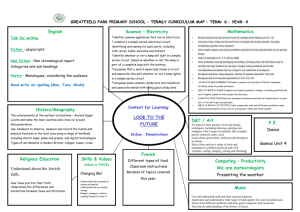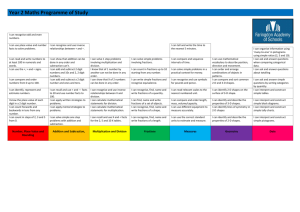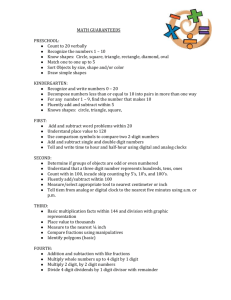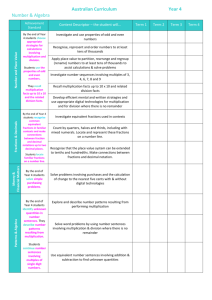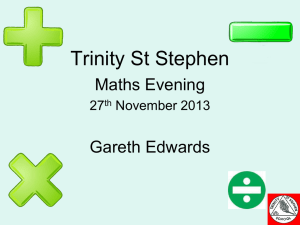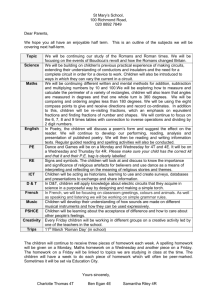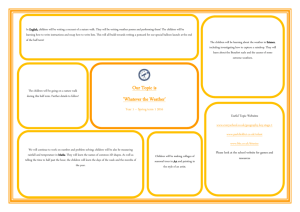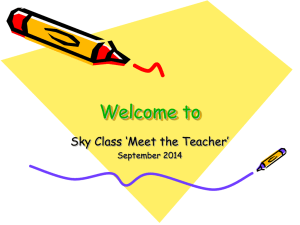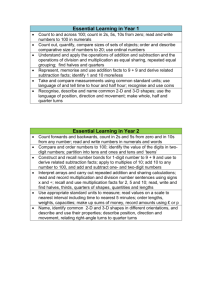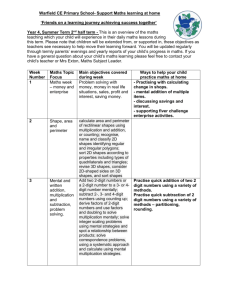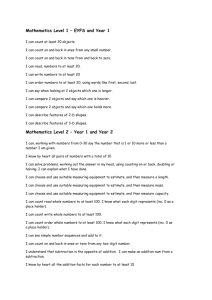Maths Level 3
advertisement
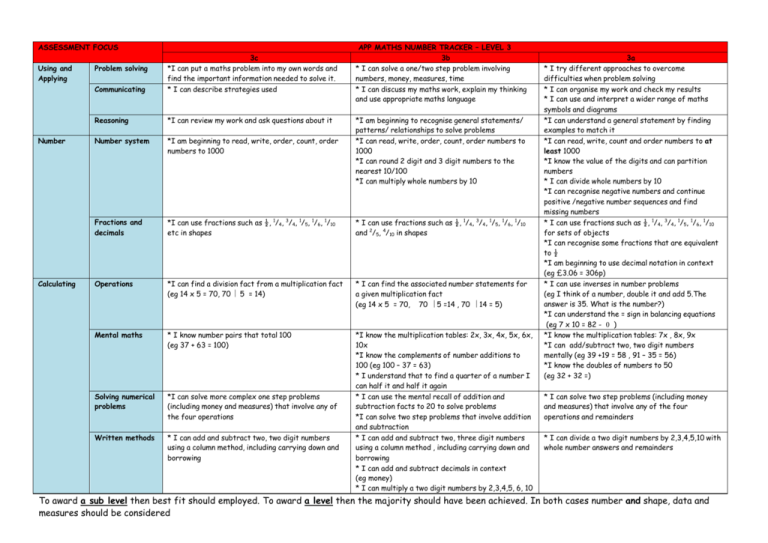
ASSESSMENT FOCUS Using and Applying Number Calculating APP MATHS NUMBER TRACKER – LEVEL 3 3b * I can solve a one/two step problem involving numbers, money, measures, time * I can discuss my maths work, explain my thinking and use appropriate maths language Communicating 3c *I can put a maths problem into my own words and find the important information needed to solve it. * I can describe strategies used Reasoning *I can review my work and ask questions about it Number system *I am beginning to read, write, order, count, order numbers to 1000 Fractions and decimals *I can use fractions such as ½, 1/4, 3/4, 1/5, 1/6, 1/10 etc in shapes * I can use fractions such as ½, 1/4, 3/4, 1/5, 1/6, 1/10 and 2/5, 4/10 in shapes Operations *I can find a division fact from a multiplication fact (eg 14 x 5 = 70, 70 5 = 14) * I can find the associated number statements for a given multiplication fact (eg 14 x 5 = 70, 70 5 =14 , 70 14 = 5) Mental maths * I know number pairs that total 100 (eg 37 + 63 = 100) Solving numerical problems *I can solve more complex one step problems (including money and measures) that involve any of the four operations Written methods * I can add and subtract two, two digit numbers using a column method, including carrying down and borrowing *I know the multiplication tables: 2x, 3x, 4x, 5x, 6x, 10x *I know the complements of number additions to 100 (eg 100 – 37 = 63) * I understand that to find a quarter of a number I can half it and half it again * I can use the mental recall of addition and subtraction facts to 20 to solve problems *I can solve two step problems that involve addition and subtraction * I can add and subtract two, three digit numbers using a column method , including carrying down and borrowing * I can add and subtract decimals in context (eg money) * I can multiply a two digit numbers by 2,3,4,5, 6, 10 Problem solving *I am beginning to recognise general statements/ patterns/ relationships to solve problems *I can read, write, order, count, order numbers to 1000 *I can round 2 digit and 3 digit numbers to the nearest 10/100 *I can multiply whole numbers by 10 3a * I try different approaches to overcome difficulties when problem solving * I can organise my work and check my results * I can use and interpret a wider range of maths symbols and diagrams *I can understand a general statement by finding examples to match it *I can read, write, count and order numbers to at least 1000 *I know the value of the digits and can partition numbers * I can divide whole numbers by 10 *I can recognise negative numbers and continue positive /negative number sequences and find missing numbers * I can use fractions such as ½, 1/4, 3/4, 1/5, 1/6, 1/10 for sets of objects *I can recognise some fractions that are equivalent to ½ *I am beginning to use decimal notation in context (eg £3.06 = 306p) * I can use inverses in number problems (eg I think of a number, double it and add 5.The answer is 35. What is the number?) *I can understand the = sign in balancing equations (eg 7 x 10 = 82 - ) *I know the multiplication tables: 7x , 8x, 9x *I can add/subtract two, two digit numbers mentally (eg 39 +19 = 58 , 91 – 35 = 56) *I know the doubles of numbers to 50 (eg 32 + 32 =) * I can solve two step problems (including money and measures) that involve any of the four operations and remainders * I can divide a two digit numbers by 2,3,4,5,10 with whole number answers and remainders To award a sub level then best fit should employed. To award a level then the majority should have been achieved. In both cases number and shape, data and measures should be considered ASSESSMENT FOCUS Shape Properties Position and movement Measures Data 3c *I can describe the properties of the shapes in Level 2b (eg flat faces, curved edges) *I can sort the shapes in Level 2b using more than one criterion (eg pentagon/not pentagon or edges equal/not equal) * I can recognise right angles in different orientations * I can recognise the shapes in Level 2b in different orientations *I can draw the reflection of a shape in a vertical/horizontal mirror line which is along the side of the shape *I can give directions using left and right *I can tell the time to the nearest 5 minutes and calculate time durations that go over the hour *I can use m/cm, kg/g, l/ml and I know which measuring tool to use * I can draw and measure lines to the nearest ½ cm APP MATHS SHAPE DATA MEASURES TRACKER – LEVEL 3 3b 3a *I understand ‘regular’ and ‘irregular’ *I can recognise the nets of a cone, cube, *I can name ‘acute’ and ‘obtuse’ angles cuboid, triangular prism, triangular *I can name ‘right angled ‘ and ‘equilateral’ /square based pyramid triangles * I can compare and order angles less than *I can draw the reflection of a shape in a 180 0 mirror line * I am beginning to recognise the nets of a cone, cube, cuboid, triangular prism, triangular/square based pyramid *I can draw the reflection of a shape in a * I can reflect a shape in a diagonal mirror vertical/horizontal mirror line which does line which runs along the side of the shape not touch the sides of the shape * I can give directions using 900 /quarter *I can give directions using clockwise and turns anti clockwise *I can use km/ m/cm, kg/g, l/ml and I know which units to use *I can read scales (eg 2, 10) to the nearest half division *I can tell the time to the nearest minute *I understand angle as a measure of turn and know 3600 is a whole turn Processing/ representing * I can gather data to answer a question using a tally chart and frequency (totals) table *I can use a Venn /Carroll diagram using more than one criterion (eg right angles and equal sides) Interpreting * I can interpret a tally chart and frequency (totals) table * I can extract and interpret information in bar charts, pictograms, Venn/Carroll diagrams *I can use km/ m/cm /mm, kg/g, l/ml and I know which units to use *I can find the area of shapes by counting squares *I am beginning to find the perimeter of squares and rectangles * I can tell the time, know am/pm and I can calculate time intervals * I can construct a bar chart (eg scale of 2) and pictogram (eg one symbol represents 10) * I understand ‘certain’ and ‘impossible’ in probability.
